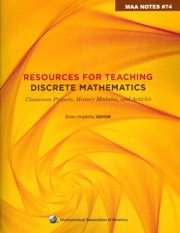Book contents
- Frontmatter
- Introduction
- Dedication
- Contents
- I Classroom-tested Projects
- The Game of “Take Away”
- Pile Splitting Problem: Introducing Strong Induction
- Generalizing Pascal: The Euler Triangles
- Coloring and Counting Rectangles on the Board
- Fun and Games with Squares and Planes
- Exploring Recursion with the Josephus Problem: (Or how to play “One Potato, Two Potato” for keeps)
- Using Trains to Model Recurrence Relations
- Codon Classes
- How to change coins, M&M's, or chicken nuggets: The linear Diophantine problem of Frobenius
- Calculator Activities for a Discrete Mathematics Course
- Bulgarian solitaire
- Can you make the geodesic dome?
- Exploring Polyhedra and Discovering Euler's Formula
- Further Explorations with the Towers of Hanoi
- The Two Color Theorem
- Counting Perfect Matchings and Benzenoids
- Exploring Data Compression via Binary Trees
- A Problem in Typography
- Graph Complexity
- II Historical Projects in Discrete Mathematics and Computer Science
- III Articles Extending Discrete Mathematics Content
- IV Articles on Discrete Mathematics Pedagogy
- About the Editor
Fun and Games with Squares and Planes
from I - Classroom-tested Projects
- Frontmatter
- Introduction
- Dedication
- Contents
- I Classroom-tested Projects
- The Game of “Take Away”
- Pile Splitting Problem: Introducing Strong Induction
- Generalizing Pascal: The Euler Triangles
- Coloring and Counting Rectangles on the Board
- Fun and Games with Squares and Planes
- Exploring Recursion with the Josephus Problem: (Or how to play “One Potato, Two Potato” for keeps)
- Using Trains to Model Recurrence Relations
- Codon Classes
- How to change coins, M&M's, or chicken nuggets: The linear Diophantine problem of Frobenius
- Calculator Activities for a Discrete Mathematics Course
- Bulgarian solitaire
- Can you make the geodesic dome?
- Exploring Polyhedra and Discovering Euler's Formula
- Further Explorations with the Towers of Hanoi
- The Two Color Theorem
- Counting Perfect Matchings and Benzenoids
- Exploring Data Compression via Binary Trees
- A Problem in Typography
- Graph Complexity
- II Historical Projects in Discrete Mathematics and Computer Science
- III Articles Extending Discrete Mathematics Content
- IV Articles on Discrete Mathematics Pedagogy
- About the Editor
Summary
Summary
This project is intended to introduce students to the concepts of mutually orthogonal Latin squares and their relationship to finite affine planes. These topics are introduced in the first section. After describing how tic-tac-toe is played on an affine plane, the second section explores player strategies. Playing the game will help students understand the combinatorial and geometric notions described, and build geometric intuition for these objects.
Notes for the instructor
Students must play the game in order to understand the strategy arguments. You can have them play against each other in class or turn in their game sheets as an exercise. While the last exercise may be an exercise in frustration, it is important for students to repeatedly play the game.
For a class project, have the members of your class play a “Tic-tac-toe on the affine plane of order 4” tournament. Our Mathematics Club holds an annual tic-tac-toe tournament at the University of Scranton with prizes for the top finishers. We have best-of-three matches to decide the winner of each random pairing, with a toss of a coin deciding who makes the first move. While perfect play will result in a win for the first player, you can rely on your students to make mistakes!
As an additional project, ask your students to create a new game to play on an affine plane. For example, how about a game where the player who claims the last unclaimed point on a line loses?
- Type
- Chapter
- Information
- Resources for Teaching Discrete MathematicsClassroom Projects, History Modules, and Articles, pp. 31 - 44Publisher: Mathematical Association of AmericaPrint publication year: 2009

